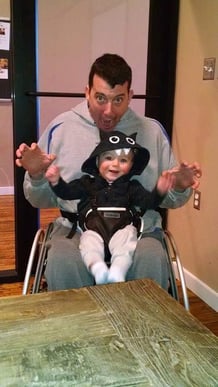Favorite adaptive baby tools - Reeve Foundation
We have a few sets of friends right now in the world of spinal cord injuries having babies, and we could not be more excited for them to start this next adventure. “Bringing home baby” carries trepidation and anxiety for most new parents, and this is especially so when one has mobility challenges. I wasn’t sure my friend Anna would ever have a baby after I left her alone once with my 3-year-old son in the kitchen while I put the younger one down for a nap. Suddenly, Anna was screaming, and I thought perhaps he had accidentally flipped her out of her wheelchair. He had, resourcefully and proudly, used the drawers to climb onto the counter and found a knife to cut a cracker, but instead of a butter knife, he was wielding the sharpest from the block; Anna was convinced he would slice off his finger. When I took the knife out of his always sticky, chubby hand, she cried. The what ifs were too much in the moment. What if she couldn’t get to him because he was on the other side of the table? What if he cut himself? What if... So, when she met her wife and they decided to have a baby, I knew who all of our “stuff” would go to along with a nice new sharp set of knives...Just kidding. No knives.
When we were having a baby, our friend Sarah gave us her bassinet on wheels along with a rocking chair with brakes which could easily be transferred into. She had just a few years previously given birth and handled babyhood from her wheelchair along with her husband. She was happy to share insight and advice about what worked and what didn’t.  Someone else had made her what we came to know as the baby log carrier, made of a quilted material soft enough for a new baby to be scooted around and pulled up and out securely from the crib. She had lent theirs out to someone else, but we had the concept and a crafty mother who could whip one up for us. This baby carrier has been passed along to three different couples with spinal cord injuries and now making its way north again to be sent along to Anna, with the bassinet on wheels and a lap harness.
Someone else had made her what we came to know as the baby log carrier, made of a quilted material soft enough for a new baby to be scooted around and pulled up and out securely from the crib. She had lent theirs out to someone else, but we had the concept and a crafty mother who could whip one up for us. This baby carrier has been passed along to three different couples with spinal cord injuries and now making its way north again to be sent along to Anna, with the bassinet on wheels and a lap harness.
The wheels were key because Geoff could push the baby around safely inside when I wasn’t home and not worry about transferring while sleeping. The Podee bottle helped because he could be hands-free to hold the baby while this Camelbak type bottle with a long tube attached to the nipple could be tucked in his pocket, etc. Geoff felt less paralyzed holding our babies while they were feeding if he didn’t have to hold the bottle too. Later, the baby lap harness came into much function. We graduated from the front pack when our GIANT infant would have to be diagonal across Geoff’s chest if we were walking the neighborhood given his seated position. We found this harness in an airplane magazine, used for toddlers on long trips, but it worked really well for us just cruising around the neighborhood before he became a walker. Geoff preferred that to pushing a stroller as he could safely be hands-free and take the babies for walks and not be stuck inside on nice days when that might otherwise have been a challenge. Our friends Aaron and Melissa have just returned the baby harness now that their little guy is fully mobile. The attached photo is Aaron and his son Dominic in harness action.
There are other adaptive cribs, obviously, but they were more expensive than what we could have afforded. Adapting one’s home to be more adept at raising babies is a uniquely individual preference. Of course, the goal is to keep the babies alive while facilitating as much independence as possible. Our kids’ knees are always scraped from skateboard falls or cycling mishaps. The fact that one of us uses a chair and one doesn’t hasn’t protected our children from every day wipeouts and the band-aids of life. Accidents happen. Chances are, their babies, like ours, will probably try to suck or chew on the rubber wheels of their chairs. This is not the end of the world-- not for you or your babies even if we are disgusted at the very thought. So far, we’ve survived the knives, the stitches of slammed doors on fingers, a few broken arms, endless scrapes, bumps, and bruises. Clearly, there is a lot more to come down the road, but sharing the tools which have worked for us may help others to feel like normal parents; there is nothing normal or regular about it for any of us.
Heather Krill is a writer- wife- teacher-mom who lives in the White Mountains of NH with her husband, Geoff, a paraplegic and professional skier, and their two children, Carver and Greta who are 8 and 6. Please check out her novel True North, website www.heatherkrill.com, author FB page Heather Krill, @heatherkrill1 on Twitter, and, most recently added in the New Year, her Youtube channel “Writing from the Front.”
Join Our Movement
What started as an idea has become a national movement. With your support, we can influence policy and inspire lasting change.
Become an Advocate